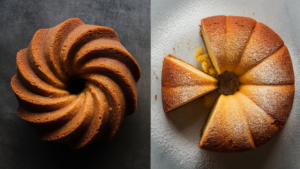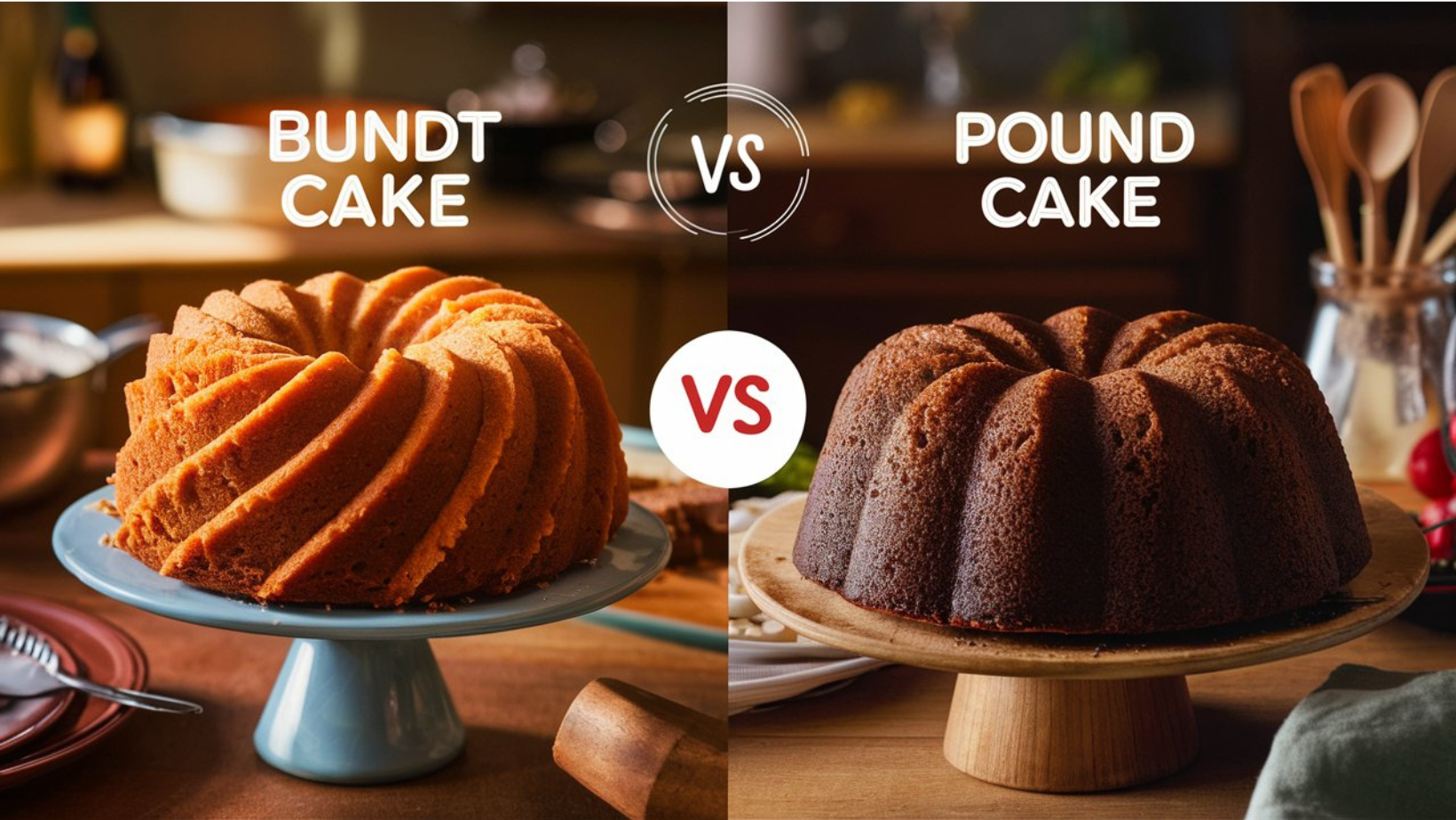Introduction
Are you puzzled about whether Bundt cakes and pound cakes are one and the same? With a multitude of cake styles gracing our tables, it’s easy to blur the lines between these two beloved varieties. This article delves deep into the essence of both Bundt and pound cakes, comparing their origins, ingredients, and culinary uses. So, let’s slice through the confusion and discover the distinctive traits that set them apart, ensuring you can proudly boast your baking knowledge at your next gathering!
What is a Pound Cake?
Historical Background
Originating from Europe in the early 1700s, the pound cake is as straightforward as it is delightful. Traditionally, the recipe called for one pound each of four key ingredients: butter, sugar, eggs, and flour. This simple formula was easy to remember and became a staple in many kitchens. Today, while the proportions may vary to suit lighter tastes and textures, the essential concept remains a cornerstone of this classic cake.
Key Ingredients and Their Proportions
At its heart, the pound cake is celebrated for its rich, dense texture, which is achieved through a high ratio of fat to flour. Modern variations might incorporate a touch of baking powder to lighten the crumb, or include flavorings such as vanilla or citrus zest to enhance the basic recipe. However, the core ingredients have stood the test of time, making the pound cake a beloved treat across generations.
In contrast, Bundt cakes do not adhere to such strict ratios, often involving a broader array of ingredients to achieve different flavors and textures. For instance, adding sour cream, yogurt, or buttermilk enriches the cake, providing a moistness that’s perfect for absorbing glazes and sauces. This adaptability makes Bundt cakes particularly popular for those who love to experiment with new variations of classic desserts.
So, while both cakes share a common heritage in the realm of traditional desserts, their ingredients and the ratios used can paint a very different story on your palate. Whether you prefer the steadfast richness of a pound cake or the moist versatility of a Bundt cake, each has its own place in the world of baking.
What is a Bundt Cake?
Definition and Origin of the Bundt Cake
The Bundt cake, unlike its pound counterpart, owes much of its identity to the design of the pan it’s baked in. Introduced in the mid-20th century by Nordic Ware, the Bundt pan was inspired by a traditional European cake known as Gugelhupf. The pan’s distinctive fluted sides and central tube allow heat to penetrate the cake more evenly, ensuring a perfectly baked result every time. This innovative design not only enhances the cake’s aesthetic appeal but also improves its texture and form, making the Bundt cake a favorite for both novice and seasoned bakers.
Distinctive Features and Design
What truly sets the Bundt cake apart is its intricate design possibilities. From elegant swirls to sharp, crisp lines, the patterns imprinted by the pan make each cake a visual delight. This allure is why Bundt cakes are often left unadorned or simply dusted with powdered sugar, allowing the design to take center stage.
Moreover, the Bundt cake can be made in a plethora of flavors and mixtures, accommodating ingredients that might be too delicate or varied for the traditional pound cake framework. Chocolate, fruits, nuts, and spices can all be incorporated into Bundt cakes, making them incredibly versatile and adaptable to seasonal ingredients. The cavity in the center of the cake is not just for show; it allows for even baking and can be used to hold fillings or garnishes, adding another layer of flavor and sophistication.
The Bundt cake has certainly carved a niche for itself in the world of baking with its blend of practicality and charm. Its ability to adapt to a multitude of flavors and presentations makes it a celebrated choice for festive occasions and casual gatherings alike. For more inspiration on creating delicious cake recipes, check out Epicurious – Cake Recipe Collection. Whether you’re a beginner or a baking aficionado, Epicurious offers a treasure trove of ideas to enhance your baking repertoire.
Differences Between Pound and Bundt Cakes
Comparison of Ingredients
While pound and Bundt cakes start with basics like flour, sugar, eggs, and butter, their ingredients differ greatly in variety and proportions. The pound cake adheres to its historic recipe with equal weights of these core ingredients. This results in a dense, buttery texture. In contrast, Bundt cakes might include sour cream, yogurt, or buttermilk. These additions create a moist and tender crumb.
Baking Process and Techniques
The baking methods for these cakes also vary. Pound cakes usually bake in a loaf or tube pan at a low temperature, which ensures a firm crust and moist interior. Meanwhile, Bundt cakes benefit from the design of their pan. The central tube allows air to circulate, enabling even and faster baking. This method helps avoid overcooked edges, common in denser cakes.
Texture and Flavor Profiles
In terms of texture, pound cakes are dense and firm, perfect for slicing neatly. They usually have a golden-brown crust with a soft, tender middle. Flavor-wise, they often stick to a buttery, vanilla base, sometimes enhanced with citrus or other flavors.
On the other hand, Bundt cakes are lighter and airier. They include leavening agents and moist ingredients like yogurt or buttermilk. These cakes embrace a range of flavors, from sweet spices and fruit to chocolate and vanilla swirls. This makes them a treat both for the palate and the eyes.
These distinctions in ingredients, baking methods, and textures underline the unique traits of pound and Bundt cakes. Each type suits different occasions, from simple teas to festive gatherings.
Versatility and Usage
Culinary Uses of Pound Cake
The pound cake has a revered status in the baking world due to its versatility. It serves as a robust base for elaborate desserts or shines on its own with simple enhancements like a dusting of powdered sugar or a drizzle of glaze. Given its sturdy texture, the pound cake is also ideal for layered desserts and can hold up well under the weight of fruit toppings or creamy layers. Its rich flavor and dense structure make it a favorite for soaking up syrups and liqueurs, allowing for a variety of flavor infusions.
Culinary Uses of Bundt Cake
In contrast, the Bundt cake is celebrated for its striking appearance and is often the centerpiece at celebrations. Its intricate mold allows for creative baking endeavors, from adding fruit and nuts to experimenting with various fillings. The Bundt cake is especially suited for occasions where its unique shape and design can be showcased. Its adaptability to different ingredients makes it a favorite for seasonal recipes, adapting easily to incorporate flavors like pumpkin in the fall or citrus in the summer. This cake’s ability to pair with a range of glazes and frostings adds another layer of versatility to its presentation.
The distinct uses of pound and Bundt cakes highlight their respective roles in culinary traditions. Whether you prefer the classic elegance of a pound cake or the decorative flair of a Bundt cake, each has its place in the art of dessert making, bringing joy and flavor to any table.
Signature Recipes

Classic Pound Cake Recipe
Ingredients:
| Ingredient | Quantity | Description | Optional |
|---|---|---|---|
| Butter, softened | 1 pound (454 grams) | Adds richness and creaminess to the cake | No |
| Granulated sugar | 1 pound (454 grams) | Sweetens the cake | No |
| All-purpose flour | 1 pound (454 grams) | Provides structure for the cake | No |
| Eggs | 1 pound (454 grams), about 9 large | Binds ingredients and adds structure | No |
| Vanilla extract or lemon zest | 1 teaspoon | Enhances flavor with a subtle aroma and taste | Yes |
Method:
- Preheat your oven to 325°F (165°C) and grease a loaf or tube pan.
- Cream the butter and sugar together until light and fluffy.
- Gradually add the eggs, one at a time, beating well after each addition.
- Sift in the flour and fold gently until just combined.
- Stir in vanilla extract or lemon zest for added flavor.
- Pour the batter into the prepared pan and smooth the top.
- Bake for 60-70 minutes, or until a toothpick inserted into the center comes out clean.
- Let cool in the pan for 10 minutes, then turn out onto a wire rack to cool completely.
Celebration Bundt Cake Recipe
Ingredients:
| Ingredient | Quantity | Description | Optional |
|---|---|---|---|
| Cake flour | 2 1/2 cups (312 grams) | Provides a fine, soft texture for the cake | No |
| Baking powder | 1 teaspoon | Helps the cake rise | No |
| Baking soda | 1/2 teaspoon | Works with sour cream to leaven the cake | No |
| Salt | 1/2 teaspoon | Enhances the flavors of the other ingredients | No |
| Butter, softened | 1 cup (226 grams) | Adds richness and moisture to the cake | No |
| Granulated sugar | 1 1/2 cups (300 grams) | Sweetens the cake | No |
| Large eggs | 4 | Bind the ingredients and help the cake structure | No |
| Vanilla extract | 1 teaspoon | Provides a sweet, aromatic flavor | No |
| Sour cream | 1 cup (240 ml) | Adds moisture and creates a tender crumb | No |
| Optional: zest of one lemon or orange, or mini chocolate chips | As desired | Adds citrus flavor or chocolatey bits for texture and taste | Yes |

Method:
- Preheat your oven to 350°F (175°C) and grease and flour your Bundt pan.
- In a bowl, whisk together flour, baking powder, baking soda, and salt.
- In a large mixing bowl, cream the butter and sugar until light and fluffy.
- Add eggs, one at a time, mixing well after each addition.
- Mix in vanilla extract and sour cream, then fold in the dry ingredients until just combined.
- If using, add the citrus zest or chocolate chips and stir to distribute evenly.
- Pour the batter into the prepared Bundt pan, smoothing the top.
- Bake for 45-55 minutes, or until a toothpick inserted comes out clean.
- Let the cake cool in the pan for 15 minutes, then invert onto a rack to cool completely.
These recipes showcase the traditional and innovative aspects of both pound and Bundt cakes. Whether you’re baking for a quiet family dinner or a festive party, these cakes promise to deliver both comfort and celebration to your table. Enjoy experimenting with these foundational recipes, and feel free to adapt them with your favorite flavors and toppings to create your own signature desserts.
Decorating Techniques for Pound and Bundt Cakes
Enhancing Pound Cakes
Pound cakes provide a classic, elegant canvas for various decorations that elevate their simple appearance into something spectacular. For subtle enhancement, a dusting of powdered sugar or a light glaze adds just the right touch of sweetness. On more elaborate occasions, you can adorn pound cakes with layers of fresh fruit, drizzles of rich chocolate ganache, or decorative swirls of buttercream. To add a festive twist, consider incorporating edible flowers or delicately placed fruit slices for colorful, natural decoration.
Creative Bundt Cake Decorations
The unique shape of Bundt cakes makes them ideal for showcasing creative decorating techniques. A well-executed glaze that fills the contours can highlight the detailed design of the pan. For a burst of color and texture, sprinkle crushed nuts, seeds, or colorful sprinkles over the wet glaze. Seasonal decorations like candied pumpkin seeds in the fall or sugared cranberries in winter enhance the festive feel. Additionally, filling the central cavity with whipped cream, fresh berries, or citrus-infused curd adds an unexpected and delightful finish.
These decorating tips enhance the visual appeal and eating experience of both pound and Bundt cakes. Whether for a formal event or a casual family gathering, creatively adorned cakes impress and delight guests. By experimenting with these techniques, you can transform any basic cake into a beautiful and delicious work of art.
FAQ Section
Are Bundt cakes and pound cakes interchangeable in recipes? You can often swap a Bundt pan for a tube or loaf pan in pound cake recipes. However, pound cake batter may not display Bundt pan designs well due to its density. Also, Bundt cakes often have different ingredients, making them not always suitable for pound cake recipes.
Can you use a Bundt pan for traditional pound cake recipes? Yes, you can! A Bundt pan can add visual appeal to the dense and rich pound cake. Keep in mind that cooking times might change slightly. The pan’s design allows for more even baking and quicker cooking.
What makes a Bundt cake different from other cakes? A Bundt cake’s main feature is its pan. The pan has fluted or grooved designs, creating decorative shapes. This design also helps cook the batter evenly. Bundt cakes often include a variety of flavors and ingredients, making them versatile for many recipes.
These FAQs highlight the subtle differences between pound and Bundt cakes. Both are beloved but have distinct preparation and presentation methods. Whether you choose a classic pound cake or a creative Bundt, each offers unique baking opportunities.
Conclusion
We’ve explored the nuances of pound and Bundt cakes, from their origins to their culinary uses. Each cake has its own charm and suits different occasions. The pound cake is ideal for those who value tradition and simplicity. It serves as a versatile base for many desserts. Meanwhile, the Bundt cake invites creativity, making any event special with its striking appearance.

